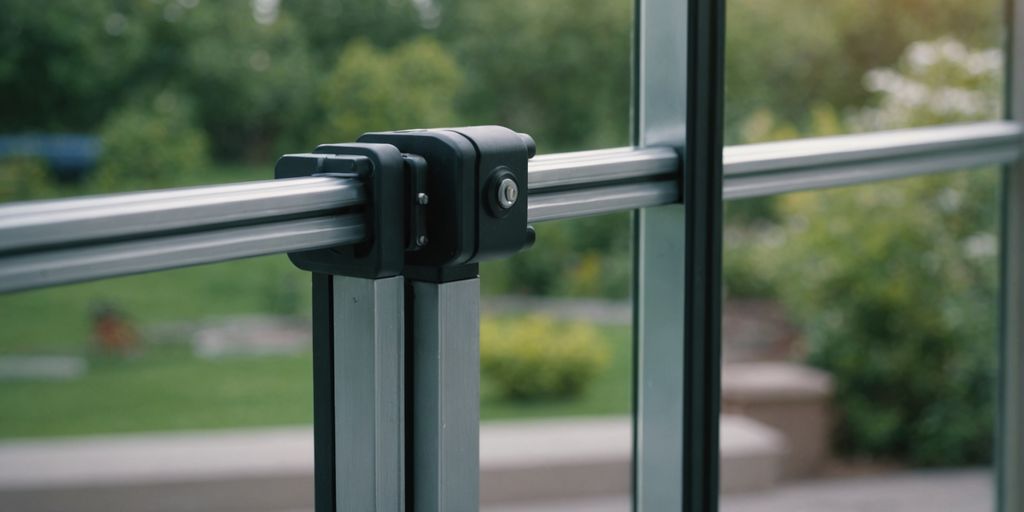
Guide to Sliding Glass Door Track Repair Parts: What You Need to Know
Sliding glass doors are a fantastic addition to any home, offering easy access to the outdoors and filling rooms with natural light. However, over time, these doors can experience issues that make them hard to open or close. This guide will show you how to tackle common problems, identify necessary repair parts, and maintain your door to keep it functioning smoothly.
Key Takeaways
- Patience is crucial when dealing with sliding glass doors to avoid damaging the door or its components.
- Basic tools like screwdrivers, utility knives, and stiff brushes are essential for most sliding door repairs.
- Removing the door safely is the first step in many repair processes, and having a helper can make this easier.
- Identifying the manufacturer and taking accurate measurements are key steps in finding the right replacement parts.
- Regular cleaning and lubrication can extend the life of your sliding glass door and prevent common issues.
Common Issues with Sliding Glass Door Tracks
Sliding glass doors are a great way to let natural light into your home, but they can have some common problems. Knowing these issues can help you fix them quickly.
Essential Tools for Sliding Glass Door Track Repair
Repairing a sliding glass door track can be a straightforward task if you have the right tools. Having the correct tools on hand can make the job much easier and faster. Here are the essential tools you'll need for most sliding glass door track repairs.
Basic Tools You Will Need
- Phillips head screwdriver: Most commonly used for removing screws.
- Flathead screwdriver: Useful for prying and scraping tasks.
- Utility knife: Used for cutting screen material and removing old weatherstripping.
- Stiff brush: For cleaning debris from the track.
- Rags: For cleaning and wiping surfaces.
- Replacement parts: These will vary depending on the repair you need to make, but could include rollers, weatherstripping, or screen material.
- Silicone spray: For lubricating the rollers (Do not use WD-40).
Optional Tools for Specific Repairs
- Socket wrench: Needed for some adjustments on certain doors.
- Needle-nose pliers: Helpful for gripping small parts or removing stubborn weatherstripping.
- Tape measure: For pre-cutting weatherstripping or screen material.
- Pry bar: Useful for removing the door from its track.
- Vacuum: To clean up debris from the track area.
Safety Equipment
- Gloves: To protect your hands from sharp edges and debris.
- Safety glasses: To protect your eyes from dust and debris.
- Helper: Sliding glass doors are heavy and fragile, so having someone assist you can prevent accidents.
Remember, using excessive force can damage the door, its track, or its components. Patience and the right tools are key to a successful repair.
Step-by-Step Guide to Repairing Sliding Glass Door Tracks
Removing the Door Safely
Before you start, make sure you have someone to help you. Sliding glass doors are heavy and can be tricky to handle alone. Safety should always come first. Carefully lift the door out of its track and place it on a flat surface, like a pair of sawhorses.
Cleaning and Lubricating the Track
- Use a soft-bristled brush or a toothbrush to sweep out any debris from the track.
- Vacuum the remaining dirt using a handheld vacuum cleaner for better maneuverability.
- Spray a silicone-based lubricant along the entire track. Wipe off any excess to prevent dirt buildup.
Pro tip: Slide the door open while cleaning and lubricating to reach hidden crevices.
Reinstalling the Door
- Align the door with the bottom track and tilt it up into place.
- Reattach the head stop to secure the door and prevent it from falling out.
- Roll the door towards the latch-side jamb and adjust the screws until the door is parallel with the jamb.
If you need replacement parts, such as a 3 part guide assembly - white, make sure to source them from a reliable supplier.
How to Identify and Source Replacement Parts
Finding the Manufacturer
Before you can find the replacement parts, you need to know who made your sliding door. Knowing the manufacturer helps you get the right part, so you can be sure it will fit and work correctly.
Locating the Manufacturer’s Name
The manufacturer’s name is often hidden in plain sight. Look for a stamp or etching on the door’s hardware or in a corner of the glass panel. This marking is usually small but should be fairly easy to find if you look closely.
Decoding Model Numbers and Serial Codes
Once you’ve found the manufacturer’s name, look for a model number or serial code. These are typically located near the manufacturer’s name or on a separate label. Check the edges of your door for a sticker or etched label.
Contacting the Manufacturer for Information
If you can’t find the manufacturer’s information on the door itself, try contacting local door retailers. They often have databases of door designs and can help identify your door’s maker based on its appearance and features.
Measuring for Replacement Parts
Even small measurement discrepancies can lead to ill-fitting components, so take your time on this step and measure your parts carefully.
To determine your door’s size, measure the height and width of the sliding panel’s exposed glass. To determine “handing,” stand outside facing the closed door. If the sliding panel is on the right, your door is “right-handed.”
Different parts often require different measurement techniques:
- For rollers, measure the wheel diameter and the distance between wheel centers.
- For weatherstripping, measure the length needed and note the profile shape.
- For handles, measure the distance between screw holes.
Many manufacturers provide specific measurement guides for their products. If available, use these to ensure you’re taking the right measurements for your particular door model.
Where to Buy Replacement Parts
Once you’ve identified your door and the parts you need, it’s time to source them. Here’s where you can find replacement parts:
- Manufacturer-specific retailers: Your best source for replacement parts is often retailers that sell new doors of the same make as yours. These specialized dealers are most likely to have exact matches for your door’s components.
- Online marketplaces and specialty stores: Online platforms offer a wide variety of replacement parts, often at competitive prices. Look for sellers specializing in door hardware for the best selection.
- Local hardware stores and home centers: Your local hardware store may have suitable options for more common parts like weatherstripping or basic rollers. They can often order specific parts if they don’t have them in stock.
Finding the right replacement parts for your sliding glass door can be a bit of a challenge, but with careful measurement and by knowing where to look, you can ensure your door continues to function smoothly for years to come.
Maintaining Your Sliding Glass Door for Longevity
Regular maintenance can prevent many common sliding door issues and extend the life of your door. Like most parts of your house, taking care of small things regularly will save you money in the long run and prevent expensive repairs for large problems that compound over time.
Regular Cleaning Tips
Vacuum out debris regularly to keep your door track clean. Lubricate the rollers and track with a silicone-based lubricant every few months to ensure smooth operation. Avoid using grease or oil-based lubricants as they attract more dirt.
Lubrication Best Practices
For vinyl door tracks, use a non-stick silicone lubricant. For wood tracks, use a hard wax such as candle wax or beeswax. You can also find specific door track lubricants at your local hardware store or online. Apply a thin coat of lubricant to the top and bottom of the door track, as well as in the door frame where the glass door latches.
Inspecting for Wear and Tear
Inspect weatherstripping annually and replace it if it shows signs of wear. Adjust the rollers periodically to maintain proper alignment and reduce strain on the door’s other parts. Weather stripping is a vital component that helps seal the gap between the sliding door and the frame, preventing drafts and improving energy efficiency.
By following these steps once per year, you can help to keep your sliding glass door rollers and wheels functioning smoothly for years to come.
DIY vs. Professional Repair: What to Consider
Cost Comparison
When deciding between DIY and professional repair, cost is a major factor. Simple repairs like replacing worn rollers or weather stripping can be done for under $50 if you do it yourself. However, professional labor can range from $30 to $120 per hour. For major repairs, such as replacing the entire roller assembly, hiring a professional might be more cost-effective in the long run.
Skill Level Required
Your skill level plays a big role in this decision. Basic tasks like cleaning and lubricating the track are usually manageable for most homeowners. But more complex issues, like realigning the door frame, often require specialized tools and knowledge. If you're not confident in your abilities, it might be best to call in a professional.
When to Call a Professional
There are times when it's best to leave the job to the experts. If your sliding glass door has alignment issues or if the door panels are heavy and delicate, a professional can handle these challenges more safely and efficiently. Mistakes can be costly, so consider professional help for major repairs.
Sometimes, paying for expert service can save money in the long run by avoiding mistakes that could require more replacement parts.
Conclusion
Fixing and maintaining your sliding glass door doesn't have to be a daunting task. With the right tools and a bit of patience, you can keep your door gliding smoothly for years to come. Remember, regular cleaning and lubrication are key to preventing common issues like sticking or squeaking. If you do need to replace parts, knowing your door's manufacturer and the specific components will make the process much easier. Whether you choose to tackle the repairs yourself or hire a professional, taking care of your sliding glass door will enhance your home's functionality and aesthetic appeal. Happy repairing!
Frequently Asked Questions
What are common issues with sliding glass door tracks?
Common problems include debris buildup, worn-out rollers, and misaligned tracks. These issues can make it hard to open or close the door.
How can I prevent damage to my sliding glass door track?
Regular cleaning, proper lubrication, and avoiding excessive force when opening or closing the door can help prevent damage.
What tools do I need to repair a sliding glass door track?
Basic tools like a Phillips head screwdriver, flathead screwdriver, utility knife, stiff brush, and rags are usually needed. Optional tools include a socket wrench and needle-nose pliers.
How do I find replacement parts for my sliding glass door?
First, identify the manufacturer and model number of your door. Then, measure the parts you need to replace and look for them at hardware stores or online retailers.
Is it better to repair a sliding glass door myself or hire a professional?
Simple repairs like cleaning and lubricating the track can be done by most homeowners. However, for complex issues, it may be best to hire a professional to avoid further damage.
How often should I maintain my sliding glass door?
It's a good idea to clean and lubricate the track at least twice a year. Regular inspections for wear and tear can also help keep the door in good condition.
